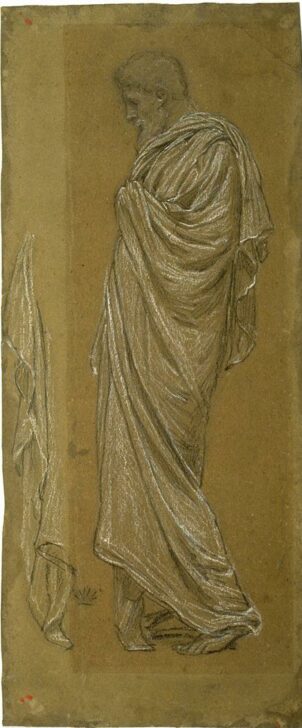Study of Oedipus for ‘A Greek Play’
Albert Joseph Moore

Description
Albert Moore
England, 1841–1893
Study of Oedipus for A Greek Play
circa 1867
Black and white chalk
Bequest of Margaret Watson Parker, 1954/1.233
Classically draped figures, which we see in Moore’s study, became an important component in British art during the latter part of the nineteenth century. This trend towards classicizing figures was reinforced by the discovery in the late 1860s of Hellenistic figurines dating from the 3rd century BCE in tombs in Greece.
Moore painted A Greek Play to adorn the proscenium of the New Queen’s Theatre in London, which opened in 1867. The painting and another smaller study are now in the collection of the Victoria and Albert Museum in London. Like Frederic Lord Leighton, Moore was inspired by classical vase painting and reliefs and incorporated motifs from these sources in his work; also similar to Leighton, Moore freely adapted what he borrowed from antiquity. He sought the beauty of effect in the graceful lines of drapery rather than fidelity to ancient Greek originals; as Moore was quoted as saying, “anachronism is the soul of art.”
(6/28/10)
Subject Matter:
This is a figure drawing of Oedipus as an old man. Oedipus was the King of Thebes in Greek mythology who unknowingly fufilled the prophecy that he would kill his father and marry his mother. When the prophecy was fufilled, he gouged his eyes out and went into exile to wander the countryside until his death. The figure of Oedipus was part of a larger tempera painting that Moore designed for the proscenium of the New Queen's Theatre, in Long Acre, London, depicting an ancient Greek audience watching Sophocles' play, "Oedipus at Colonnus".
Physical Description:
A dark line drawing with white highlights on a tan colored background. It shows a standing male figure in profile, facing left. He has curly hair, a long beard and has classically style draped clothing. He has a vacant gaze and his face is turned downward. there is a partial drawing of draped fabric in the left margin of the work.
Usage Rights:
If you are interested in using an image for a publication, please visit https://umma.umich.edu/request-image/ for more information and to fill out the online Image Rights and Reproductions Request Form.